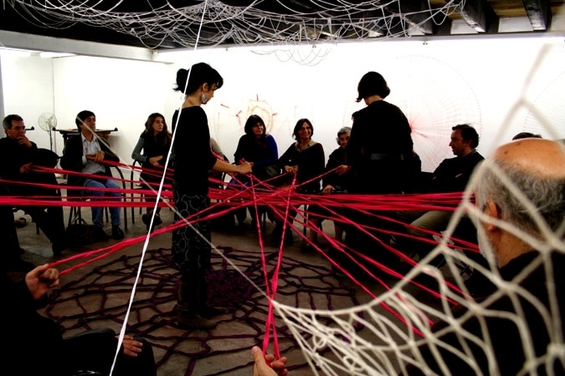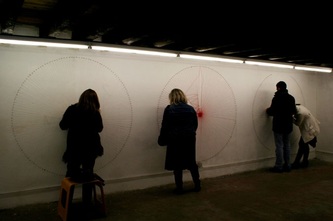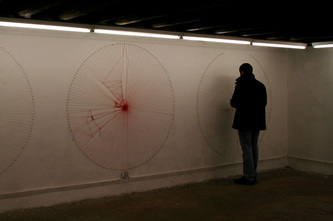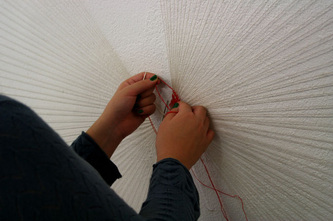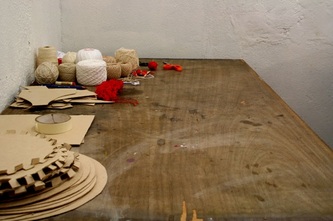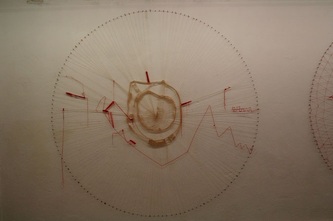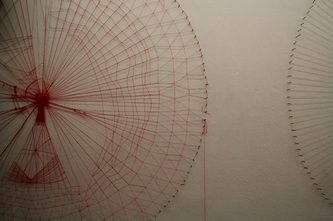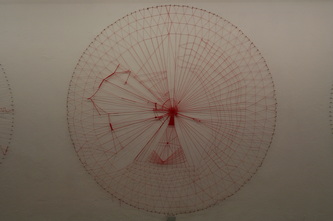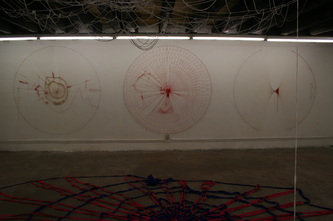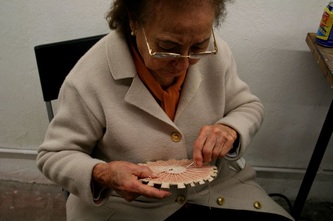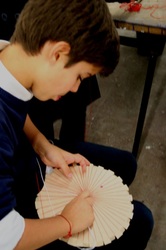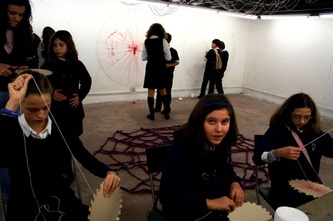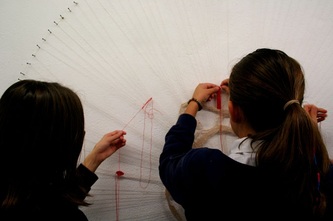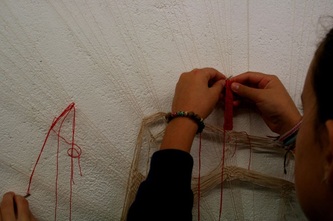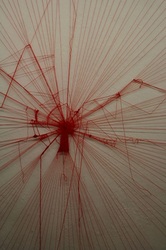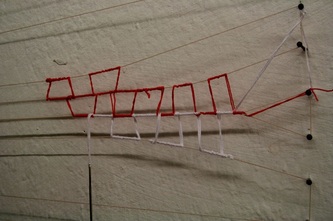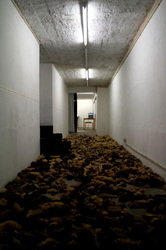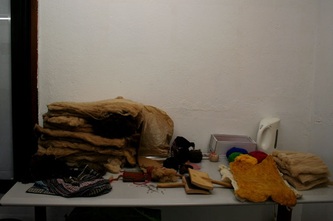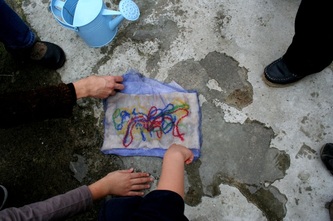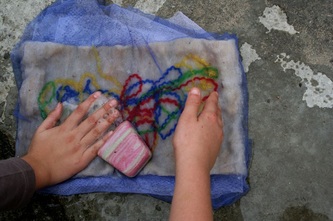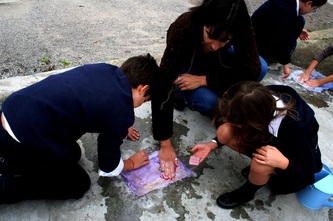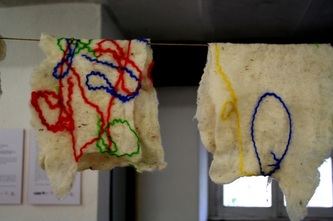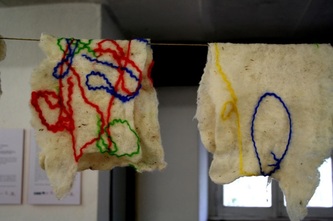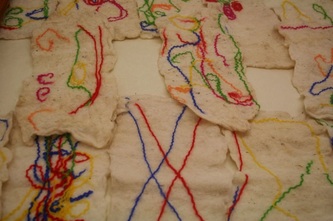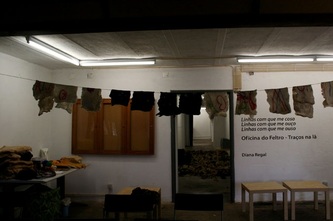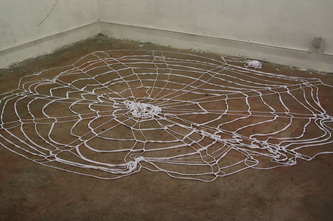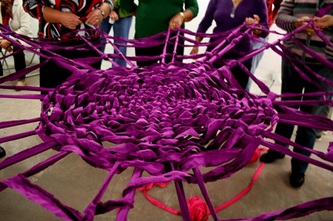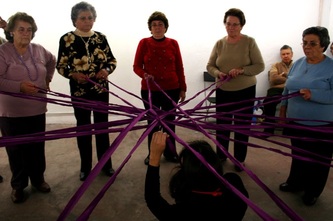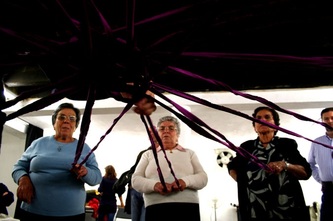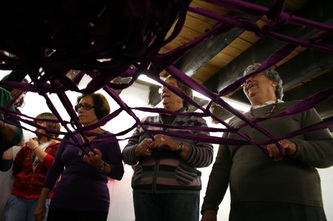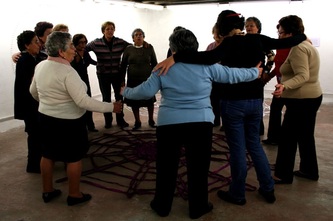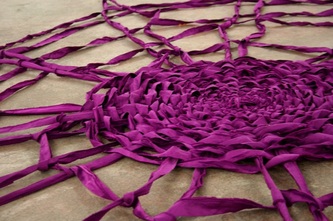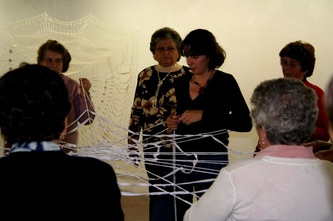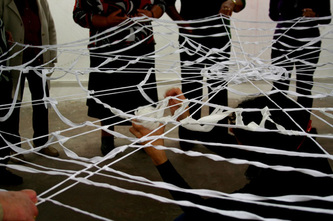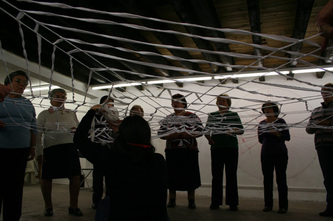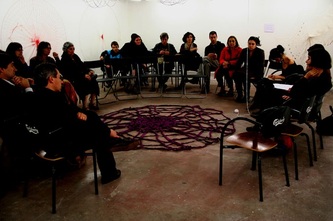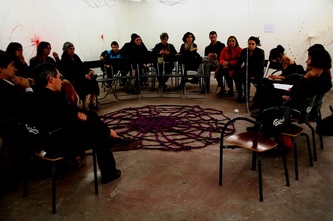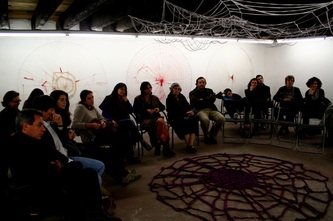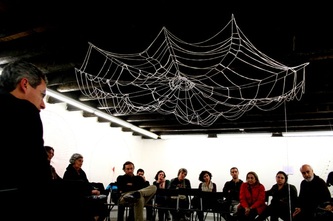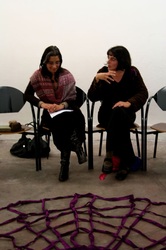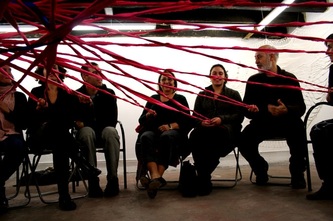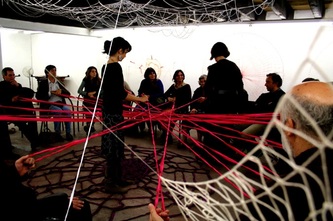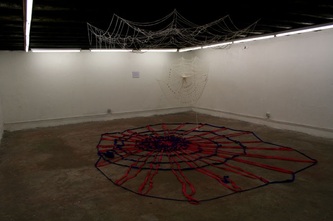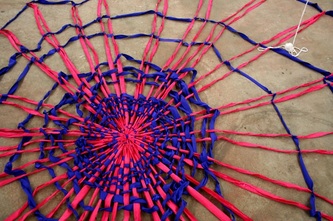_© All rigths reserved to Associação Espaços do
Desenho-Drawing Spaces. Text.Sound.Video.Images
_
REPORT 2 - IDEAL
Intercultural Drawing for European Adult Learning
Intercultural Drawing for European Adult Learning
‘LINES with which I weave myself, lines with which I
listen to myself, lines with which I venture myself’
Series of ACTIVITIES AND WORKSHOPS
Drawingspaces, Lisbon, Portugal
12 – 21 November 2009
Series of ACTIVITIES AND WORKSHOPS
Drawingspaces, Lisbon, Portugal
12 – 21 November 2009
WHAT
1. Framed drawings - construction of “framed drawings” made with strings, cardboards, wall and nails, based on a circular figure, with reference to particular techniques of textile production such as the Renda de Tenerife and the Renda de Milão.
2. Traces on wool – production of traditional felt incorporating drawings made with colored lines, using traditional soap, water and tulle
WHERE
Espaços do Desenho - Drawing Spaces, Fábrica Braço de Prata
Rua da Fábrica do Material de Guerra nº1, 1950 – 128 Lisbon, Portugal
www.drawingspaces.weebly.com
WHEN
12 -28 November 2009, 19h - 23h
'Framed drawings constructed with strings I' – Workshops opened to the community
14 November 2009, 19h - 23h
'Wool Festival' – Performed by a group of 20 women from Viana do Alentejo (South of Portugal) who developed a collective large net with felt strings while singing traditional songs from their region - Alentejo
15 November 2009, 16 - 19h
'Framed drawings constructed with strings I' – Workshop opened to the general public
19 November 2009, 19h - 23h
'Traces on wool: drawings with traditional felt’ – workshops opened to the general public
20 November 2009, 10h - 13h
'Traces on wool: drawing with traditional felt’ – workshops opened to a group of 12 year old children
20 November 2009, 19h - 23h
'Traces on wool: drawing with traditional felt’ - Workshop open to the general publi
21 November 2009, 19.30h – 22.30h
Presentation and discussion of the project/workshops with some of the participants, invited guests and the general public. Production of a collective net, made with felt strings, during the discussion with the participation of the public
WHO
Facilitators and Staff
Diana Regal
Elisa Pinto
Teresa Carneiro
Ana Marin
Daniela Vasco
Sara Barriga (discussant of the project – 21 November 2010)
Adult Learners
79 adult learners (who signed in for the activities); 57 women and 42 men
20 elder women from Viana do Alentejo (South of Portugal) – organized in partnership with the platform Modes of Doing [Modos de Fazer]
24 children from a preparatory school
WHY - CONTEXT
1. Framed Drawings
The title of this project was an appropriation of a visual poem by Regina Guimarães (Portuguese writer with a vast work/research on the written and sung word), which has served to name the actionsthat followed the project with the purpose of reflecting upon the practices of production and transformation of textiles at the beginning of the 20th century in the domestic context in Portugal, when such practices were used for the manufacturing of clothes and other home textiles.
Fully aware that working with textiles usually implicates gender connotations (in its relations with female work) or economic connotation, either within a global or domestic economy, the aim of these actions has been to re-establish relations with such practices, and explore the interrelations implicated in such activities, and their associated techniques and instruments, and also to address some of the legends and myths which have been attached to them as well as the drawings made to accompany these processes and all of the elements that so often have been forgotten by those who are still involved with the textile industries. (Translated from a text by Diana Regal written for the purpose of this project)
2. Traces on wool
The work developed during the project Traces on Wool was based on the platform for artistic investigation/creation Modes of Doing [Formas de Fazer], under the responsibility of Diana Regal, which aims to reestablish and reinvent traditional means of felt production as collective and ancient processes of knowledge through the use of wasted wool resultant from sheep-shearing. (Translated from a text by Diana Regal written for the purpose of this project)
HOW - PROCESS
1. Framed Drawings
This first activity proposed the construction of “framed drawings” made with strings, based on a circular figure which referred back to particular techniques of textile production such as the Renda de Tenerife and the Renda de Milão.
This action was also supported by a magazine, which was made available during the project that collected several drawings showing different techniques, based on the circular figure, which the participants could undertake as basis for their work.
This action was divided into two parts:
- Exhibition and installation of works on textiles, textile instruments and materials, graphic poems, etc;
- Open workshops for the community:
Framed drawings on the wall
- In preparation for this activity, 3 sets of large circular shapes were constructed onto the wall with nails marking the extremities of the circles and strings crossing through the centre of the shapes connecting the various extremities around the circles, from one side to the other, through the centre.
- The participants were then invited to collaborate onto producing drawings with different colored lines, passing these lines through the strings holding the circle, with different shapes and configurations. Participants were encouraged to experiment with regular and irregular shapes, as well as to collaborate with one another by responding to parts of works produced in the same circular figure by another participant. Simple and more complex drawings from traditional textiles were made available as references for this activity.
- Each of the three drawings undertook several sessions to be accomplished and the intervention of different participants who sign in for the project on each day, while continuing the work of previous participants
Framed drawings on cardboards
- In preparation for this activity, several cardboards were cut into different small shapes (no bigger than an A3 size), some following the circular form, some following more irregular forms.
- The participants were also invited to create their own shapes by choosing how to cut the cardboards themselves.
- Each participant then produced several cuts measuring 4 cm, regularly around the extremities of his/her cardboard and then passed several strings through these cuts connecting opposite extremities to one another, either by passing the strings through the centre of the cardboard or by choosing more irregular shapes while not connecting the extremities through the centre of the cardboard (see examples on the images of this report).
- Participants then experimented drawing with different colored lines, by passing these through the strings holding the circular or irregular shapes on the cardboard, forming different shapes and configurations. Simple and more complex drawings from traditional textiles were made available as references for this activity. Participants were encourage to experiment regular and irregular shapes, as well as to collaborate with one another by responding to parts of works made in the same circular figure by another participant. The outcome of these experiences was exhibited as the works were being developed.
2. Felt Workshop – Traces on wool
Traces on wool was set up with the purpose of reconnecting while reinventing traditional means of felt production as collective and ancient processes of textile knowledge through the use of wasted wool resultant from sheep-shearing. In practice, this set of workshops proposed to creatively explore the cycle processes of wool: from sheep-shearing to carding, spinning and weaving, by using some basic strategies for making felt while integrating colored lines onto ‘pure’ wasted wool as it was being transformed into felt pieces.
Traces on wool was developed through several stages and activities:
- The presentation of the book História de um tapete e Arca de Noé [The story of a tapestry and Noah’s Ark] with texts by Regina Guimarães; includind a session of storytelling by Joaninha de Almeida directed to children, parents and the general public;
- The presentation of the documentary Moiras by Regina Guimarães about a Felt Workshop developed in Viana do Alentejo (South of Portugal) in 2008 by Diana Regal and Women from the region, which was inspired in ancestral methods of Felt making, not specific to any place or nation, and which aim to invest on an economically unviable project concerning the re-using of wool;
- Workshops of traditional felt – this set of workshops proposed to creatively explore the cycle processes of wool: from sheep-shearing to carding, spinning and weaving, by using some basic strategies for making felt while integrating colored lines onto ‘pure’ wasted wool as it was being transformed into felt pieces. First, the participants were guided to develop pieces of felt through the recreation of traditional practices which then served as ‘support’ for drawing. Next, the participants were guided to draw by composing different configurations of colored strings over the felt, creating elements that could be read as thematic or abstract, by means of contemporary visual languages. The process of felt making was created with soap, water and tulle; the colored lines were integrated on the felt after this first stage; the pieces of wool were then rolled again with tulle, deeply massaged with traditional soap and water and then opened up, hanged on string, and left to dry like drying clothing. These works were exhibited as they were put to dry in the space and later were displayed in showcases (see photos of the stages of the exhibition/project).
accommodation
Drawing Spaces facilities: 2 event rooms, one large corridor also serving as a workspace, outdoor space just outside drawing spaces, various tables, chairs, cardboards, nails attached to walls in circular shapes, cardboards, different types of strings (various colors), wool, felt (various colors), wool strings (various colors, ‘straight’ and with ‘curved shapes’), scissors, soap, water, tulle
VALUE FOR LEARNERS
Participants were enabled to engage in a drawing activity literally using physical lines to draw in space while re-connecting to back to particular techniques of textile production such as the Renda de Tenerife and the Renda de Milão and making felt out of sheared wool. In this way, participants had the opportunity to recreate such traditional means of working into new expressive and contemporary work, investing these practices with new aesthetic value.
Participants were easily engaged with these workshops as they immediately connected to their traditional existence. They were very curious with working with traditional processes while being free to transform them into new shapes, drawings and works. Participants also engaged very easily with the collaborative parts of the project. For many, it was easier to participate in the project by continuing someone else’s work, already developed at a previous stage in the process. It was of extreme importance to the participants to work along with facilitators in the project, experimenting together with techniques, collaborating on decision making and on the production of work. This workshop involved very much working with the hands and the sense of touch. Particularly during the felt workshops, participants felt very enthusiastic in the processes of feeling the materials while transforming them with their own hands. This gave them a sense of empowerment and confidence which allowed a deep engagement of the participants with the activities.
It was extremely rewarding to observe how the group of elder women that came from a village in the south of Portugal to participate in the ‘wool festival’ – one day project, responded to the project with such enthusiasm and sang traditional songs from their region while producing a huge collaborative net. At the end of making the net, the put their arms around each other’s shoulders in a circle around the net they produced, and continued to sing traditional songs while balancing their bodies around the work. The public was extremely moved by this moment.
VALUE FOR FACILITATORS
Immediately from the beginning of the project, facilitators understood that for this activities to succeed, they would need to be fully engaged in the working processes, along with the participants, not only to demonstrate ways of doing and use and handling of techniques, but also to show that this was part of a collaborative project between facilitators and participants in terms of experimenting techniques together and developing outcomes as part of a shared experience.
Facilitators realized how active and available one needs to be to develop this sort of activities. Facilitators needed to be always available and willing to work together with participants, whether individually or in group. Facilitators also learned a lot from participant’s responses to the project. In such an opened proposal the creative contribution of each participant is what makes the project work and move into new discoveries and directions.
This was a very rewarding experience for facilitators also in terms of working as a team. They had to collaborate constantly with one another, and exchange roles continually in response to the participants needs throughout the activities.
It was extremely enriching for the facilitators to work with such a varied group of participants throughout the days of the activities, as they were pushed to develop their skills in terms of quickly adapting to new daily situations as much as being constantly flexible to engage with new paths from a variety and ever changing responses resultant from having different groups of participants throughout the project.
VISUAL RECORDS
